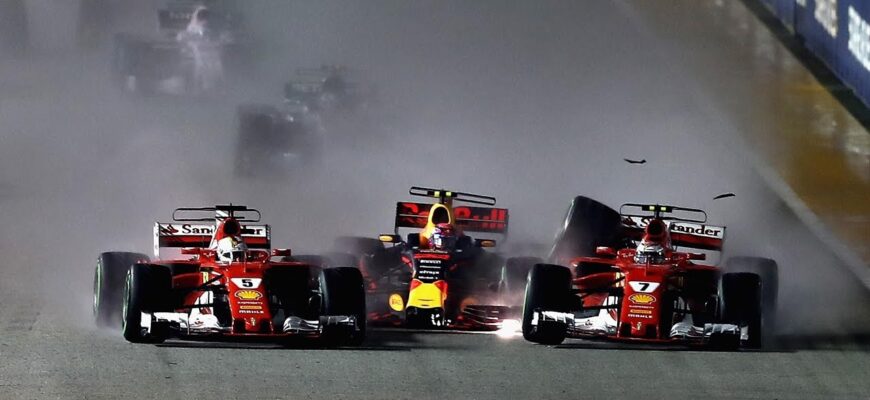Singapore. A city of shimmering skyscrapers, a vibrant culture, and a Grand Prix circuit that twists and turns under the dazzling night sky. But beneath the glamour lies a brutal reality for Formula 1 drivers: an unforgiving crucible of heat and humidity that pushes human endurance to its absolute limits. As the sport returns to the Marina Bay Street Circuit, the spotlight isn`t just on raw speed, but on a more fundamental battle – the fight against nature itself, now intensified by a formal `heat hazard` declaration.
- The FIA`s Bold Move: A `Heat Hazard` Declared
- The Unseen Battle: Physiology Under Pressure
- Engineering a Cool Solution: The Evolution of the Vest
- Early Challenges and Ongoing Refinements:
- A Driver`s Perspective: Comfort vs. Competitiveness
- Beyond the Vest: The Future of Driver Welfare
- Conclusion: Staying Cool Under the Collar
The FIA`s Bold Move: A `Heat Hazard` Declared
For the first time in its history, Formula 1`s race director, Rui Marques, has invoked a special `heat hazard` regulation for the Singapore Grand Prix. With forecasts predicting temperatures hovering around 31°C (88°F) and humidity soaring above 75%, this isn`t just uncomfortable; it`s a genuine threat to driver safety and performance. The ruling allows drivers the option of wearing advanced liquid-cooled vests, a seemingly simple solution to a complex problem. But F1 is never simple. To accommodate the necessary hardware, the minimum weight of the car is increased by five kilograms. Drivers opting not to wear the vest must still carry equivalent ballast, ensuring no competitive advantage is gained or lost.
This proactive measure stems directly from the harrowing experiences of the 2023 Qatar Grand Prix, where several drivers teetered on the brink of collapse. Williams` Logan Sargeant was forced to retire due to severe heat stress, while Lance Stroll barely made it out of his car before succumbing to the conditions, having nearly blacked out in high-speed corners. These incidents served as a stark, sweaty reminder that even the fittest athletes on the planet have their breaking point.
The Unseen Battle: Physiology Under Pressure
Imagine being strapped into a cockpit, surrounded by a screaming engine and hot asphalt, in conditions akin to a tropical sauna. This is an F1 driver`s reality in Singapore. During a two-hour race, drivers can shed as much as three kilograms of body weight – a staggering three liters of fluid – purely through sweat. Depending on their starting weight (which can range from the low 60s to 75 kilos), this represents a 4% to 5% body-weight loss.
Such rapid dehydration has severe consequences:
- Cognitive Decline: Even a 2% dehydration can impair concentration, decision-making, and reaction times. In a sport where milliseconds separate glory from disaster, this is unacceptable.
- Physical Exhaustion: Muscles tire faster, and the heart has to work harder to pump blood, exacerbating fatigue.
- Heat Stroke Risk: Core body temperature can rise dangerously, leading to dizziness, confusion, and even loss of consciousness. The G-forces experienced in an F1 car, often exceeding 5G, only intensify these physiological demands, making every turn a test of sheer willpower and physical resilience.
Engineering a Cool Solution: The Evolution of the Vest
The concept of cooling vests isn`t new to high-performance athletes, but integrating them seamlessly into the hyper-regulated, high-stress environment of Formula 1 presents unique engineering challenges. These vests work by circulating a cooled liquid through an intricate network of thin tubes stitched directly into the garment.
Early Challenges and Ongoing Refinements:
- Comfort Conundrums: Drivers complained that connecting valves, initially placed on the side, became unbearable under the immense G-forces. Subsequent designs have sought more ergonomic placements. The thick, fireproof material and embedded tubing also proved cumbersome under their race suits, adding another layer of discomfort.
- Reliability Roulette: A cooling system is only as good as its reliability. Concerns were raised about potential failures that could transform a driver`s lifeline into a literal heat insulator – an ironic and dangerous twist.
However, teams and specialist suppliers have been working tirelessly over the past two years to refine these systems. Ferrari driver Carlos Sainz notes the progress: “At the beginning, we had it to work more or less for half an hour. Hopefully now the whole system can work at least for an hour. It`s a two-hour race… if it works, it`s better, because then you suffer a bit less.” A pragmatic view from a man who knows what it`s like to endure the full Singaporean ordeal.
A Driver`s Perspective: Comfort vs. Competitiveness
The drivers, the ultimate arbiters of comfort and effectiveness, offer a mixed bag of opinions. George Russell, clearly a fan, welcomes the innovation: “When you`re racing in 90% humidity and the cockpits are getting on for 60 degrees, it`s a bit of a sauna inside the car. So I think we all welcome it.” The concept, he notes, is good, even if personal adjustments are still needed.
Seven-time champion Lewis Hamilton, however, remains unconvinced by the current iteration: “It`s quite uncomfortable. It itches a lot so I`m not sure I want to drive with an itchy top on.” One can almost hear the exasperated sigh of a champion weighing the marginal gain against the irritating scratch.
Perhaps the most persuasive argument comes from Nico Hulkenberg. After a brutal Saudi Arabian Grand Prix, where he endured the heat without a vest, he witnessed his rival Alex Albon (who did wear one) emerge “fresh like a spring chicken.” The experience was enough to convert him: “Next time I`m going to run that thing.” A direct, real-world comparison that speaks volumes.
Beyond the Vest: The Future of Driver Welfare
The introduction of the `heat hazard` rule and the ongoing development of cooling vests highlight Formula 1`s commitment to driver safety, even as it continues to push the boundaries of human and mechanical performance. While some drivers might still grumble about an itchy vest, the underlying goal is clear: to mitigate the risks of extreme environmental conditions and ensure that the battle on track remains one of skill and speed, not sheer survival. As F1 races increasingly in diverse and often challenging global climates, such innovations will undoubtedly become a standard, integral part of the sport`s evolving landscape. The Singapore Grand Prix, a spectacular showcase of speed and light, also serves as a poignant reminder of the relentless heat that defines its unique challenge.
Conclusion: Staying Cool Under the Collar
Singapore’s Grand Prix is a magnificent spectacle, but it’s also a stark reminder of the immense physical toll exacted from its competitors. The new ‘heat hazard’ rule and the sophisticated cooling vests are not merely technical gadgets; they are crucial instruments in safeguarding driver health and maintaining the integrity of the sport. As the cars flash under the night lights, the real victory might just be in staying cool under the collar – and under the race suit.








